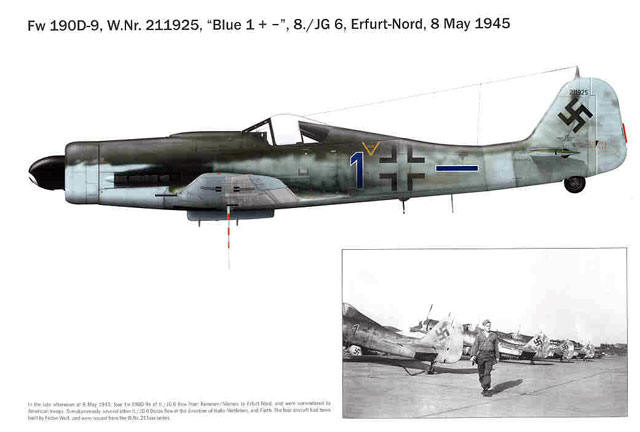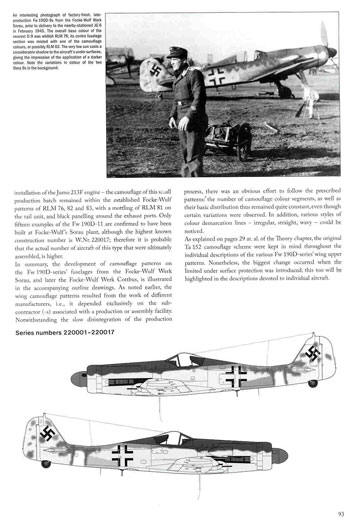|
Title,
Description & Publisher |
Focke-Wulf Fw 190D – camouflage & markings
Part 1
Authors: Mark Debroek, Eric Larger & Tomáš PorubaArtists:
Tomáš Poruba, Jaroslav Farkaš, Mark Debroek & Eric Larger
Publisher: JaPo, Hradec Králové, Czech Republic
ISBN: not indicated |
|
Media
and Contents: |
208 pages, hard cover; portrait format (22 x
30 cm) |
|
Price: |
Unknown at time of writing |
|
Review
Type: |
Detailed Review |
|
Advantages: |
Most comprehensive analysis of Fw 190D-series
camouflage and markings yet published. Part 1 of a possible
three-volume set. Highly analytical approach to unravelling
Fw 190 D camouflage and markings schemes, identification of
individual aircraft into specific production batches,
comprehensive Werknummer listing, etc. Outstanding
photograph collection and superb colour profiles. Destined
to be the “Dora Bible”. |
|
Disadvantages: |
None. |
|
Recommendation: |
Very Highest Recommendation
|

HyperScale is proudly supported by
Squadron.com
Reviewed by David E. Brown
“The raison d’être of this
publication on the Fw 190D-series is to capture in a single publication
the primary sources – photographs – as well as their interpretation, so
as to pass on to fellow researchers, or any other Luftwaffe enthusiast,
what are perceived to nbe the keys to identifying, c.q. classifying,
through the particularities of camouflage and markings, those “Langnasen
Doras” whose serial numbers cannot be derived fro pictures or other
reference materials.” (Authors’ Introduction to the book “Focke-Wulf
Fw 190D – Camouflage & markings – Part I”)
Appearance and Contents
This
new JaPo book is very well produced. It measures 22 x 30 cm / 9 x 12
inches, and has a laminated hard-back cover. The pages are heavy bond,
semi-matt, bright, coated paper, and the 208 pages of text and images
include:
-
248 photographs (55 colour, 193 b/w)
-
70 aircraft and component plan and scrap views
(41 colour, 29 b/w)
-
60 artist aircraft colour profiles (40 full page
size/length; 20 half size)
-
Numerous maps, charts, tables, document images,
etc.
Contents
and Organisation
The contents of the book are
logically organized, starting with and introduction on the Dora’s
operational history, followed by detailed discussion on camouflage and
markings. Subsequent sections include a comprehensive discussion of the
Fw 190 D prototype aircraft, interpretation of camouflage and markings
for each of the known Focke-Wulf Werknummer batches, and
concludes with tables on all known aircraft and their fates for these
series. Eight sections are presented in the book and are identified and
detailed below.
1. Introduction and
Operational; History (18 pages)
Entire books have, and will
be written on various Dora units’ operational histories. This
book’s focus is on camouflage and markings, yet an excellent summary
of the Dora’s operations is presented in the book supported by
several tables, maps and photographs.
2. Fw 190D Production Series
(2 pages)
This brief section is
dominated by a comprehensive chronological chart tabulating the
production of all Dora-type aircraft by each known manufacturer that
includes the Werknummern range for aircraft produced on a
monthly basis. This is great information for those requiring
knowledge of approximately when specific aircraft were produced.
Indeed, such data is critical to unravelling and understanding the
evolution of the Dora’s camouflage and markings through time.
3. Camouflage and Markings
Theory (49 pages)
This is a fascinating
chapter that includes an outstanding overview and interpretation of
Doras’ camouflage and markings, as well as interior colours. The
authors lay out their data, interpretations and the logic behind
their conclusions based on official Luftwaffe and RLM
documents, Oberflachenshutzliste plans, photographs and
aircraft parts. Numerous colour photos or wreckage and parts
provide compelling documentation supporting their conclusions.
Interestingly, the authors have designated six different wing
undersurface schemes (“W-Schemes”) that are of great importance in
helping identifying where specific aircraft fall within certain
Werknummer batches and series. Three overall uppersurface
schemes are also described: 75/83/76, 82/83/76 and 81/82/76.
Further text and figures are presented on the national markings
styles, Geschwader, Gruppenstab and Gruppe
fuselage markings for each Dora Geschwader, four pages of
tabulated information on unit tail bands, spinner spiral styles for
each unit, Werknummer styles and positioning, and finally,
two pages of plan views illustrating and describing every known
maintenance marking observed in photos and wrecks. Simply
outstanding.
4. Fw 190 Detailed
Description of Prototypes (13 pages)
This section focuses on most
of the F w190 D prototype aircraft detaining their camouflage and
markings. Photographs, documents, colour and b/w plans, drawings
and profiles are seamlessly brought together to illustrate the
authors’ interpretations.
5. Individual Description of
Production Batches (104 pages)
Herein is the bulk of the
book – 104 pages dedicated to describing the camouflage and markings
of Focke-Wulf production aircraft from the 21XXXX Werknummer-series.
Six batches described in detail with accompanying colour and b/w
photographs, colour and b/w profiles and plans, official documents,
etc., these being:
210001-210300 – 17
aircraft examples profiled
210901-211200 – 5
aircraft examples
211901-211950 – 17
aircraft examples
212101-212170 – 5
aircraft examples
213081-213100 – 2
aircraft examples
220001-220017 – 5
aircraft examples (D-11)
Grey-tone profiles for each
fuselage side, variations, and wing uppersurfaces illustrate the
salient features for each batch. Specific to every batch, a number
of aircraft are studied in detail and for each there is a discussion
on the aircraft’s history, unit, camouflage, markings and
stencilling. All sections are accompanied by period and recent
photographs up to half-page size, colour and b/w plan and scrap
views, and full-page artist profiles. The latter are in this
writer’s opinion the finest created for this aircraft. New
information is presented via new and previously unpublished photos
and documents for a number of familiar aircraft for such things as
their Werknummer, unit affiliation, camouflage colours and
the like.

Aircraft from the first
production batch are naturally better represented in the study for
the simple reason they were the first Dora’s in combat and hence had
the greatest opportunity to be photographed. Most of these aircraft
served with either III./JG 54 or IV./JG 26. Some batches have
similar representation, though others have meagre numbers of
aircraft known for their particular batch. Included are several
aircraft that have the diagnostic features of a specific batch
though their entire Werknummer is not known. That identity
of such aircraft can be narrowed down to a part within a specific
batch proves the validity of the authors’ analytical framework and
interpretations.

Based on the known totals
for each batch, the aircraft examples for each range from 3-10%
representative samples. The small 220001-220017 has five aircraft
described representing 30% of the batch. These totals are thus
statistically sufficient to permit a highly confident interpretation
of the camouflage colour, schemes and markings for each batch. This
methodical analytical approach is a textbook example of how such
studies and should be studied and is probably the first and most
detailed study of its type yet published. The results presented
therein speak for themselves.
6. Summary (1 page)
This brief section
summarizes in a single page the overall results of this study and
points out areas with particular sensitivities regarding available
data, data limitations, etc.
7. Table of Known Focke-Wulf
Production Losses (8 pages)
This final section is made
up of eight pages of tables chronicling every known Few 190 d is the
aforementioned production batches. The table format contains
information on each known aircraft’s Werknummer, date (of
significant data), marking/code, pilot, fate, location/crash site,
state, and action and remarks with approximately 40 entries per
page. This is an extremely useful table and will hopefully expand
as new information becomes available to be perhaps included in a
subsequent volume.
8. Bibliography &
Photo Credits (2 pages)
This section lists all the
published books, periodicals, and official Luftwaffe and
Allied documents used and consulted by the authors, and also
identifies photograph sources.
Click the thumbnails below to view larger images:
No book is perfect and a few
minor editorial errors were noted: such as “KG(J) 51” – this unit was
never a Me 262 “Jagd” or fighter unit, “Prussia” instead of “Russia”,
etc. For future volumes, the authors and published. The “Table of
Contents”, while present is relegated to the back of the book and not in
the front that is familiar to western readers. The headings for the
various sections should have larger font sizes to ease in locating them
in the book. Finally, it is hoped that a comprehensive Index will be
included in Volume II to facilitate locating specific information buried
in the tremendous volume of data and images contained in this book.
Regarding Part II, this will
follow the same format for those Fw 190 D-9, D-13 and D-5 aircraft
produced by Arbeitsgemmeinschaft Weserflug (400000-series),
Mimetal (500000-series) and Fieseler (6000000-series).
Additional chapters will discuss “Modifications and Adaptations of
Camouflage”, “Snapshots in Time (Aircraft of a single unit
simultaneously in use)”, “Camouflage Lifecycle of an Aircraft”, “Loss
Listings” and new information on “Fw 190 D-15 Camouflage and Markings”.
From conversations with the authors, a third volume is contemplated
which would include new information that was forthcoming following
publication of the first two volumes, Addenda and Errata, and Ta 152
camouflage and markings.
These are the best of times for
Dora fans. With the completion of this project -Volumes I and II with
over 400 pages and the potential for perhaps another 100 in Volume III
- there will be over 500 pages devoted to the camouflage and markings of
the Fw 190 D-series aircraft. In addition to these, it is expected that
the upcoming 300-page Eagle Edition book on the Dora will be a
complimentary and without a doubt another outstanding “must-have”
addition to enthusiasts’ libraries.
In conclusion, this book is an
outstanding contribution to knowledge on Luftwaffe camouflage and
markings specific to the Fw 190 D-series. It is indispensable to anyone
interested in the subject as it sets the standard for the analytical
analysis of aircraft camouflage and markings and most importantly,
extremely well presented in a comprehensive and readable format. For
modellers, one simply cannot complete an accurate scale representation
of Dora model without this book.
In my opinion, the lofty goals
by the authors quoted at the beginning of this review have been met and
exceeded by their book, and hopefully the subsequent volumes. Loftiest
kudos to Mark Debroek, Eric Larger and Tomáš Poruba for their superb
publication.
Highest Recommendation
Sincere thanks to
Ales Janda at JaPo for the review copy of this book.
Review Copyright © 2005 by David E. Brown
This Page Created on 04 December, 2005
Last updated 13 December, 2005
Back to HyperScale Main Page
Back to Reviews Page
|
Home | What's
New | Features
| Gallery |
Reviews | Reference
| Forum
| Search